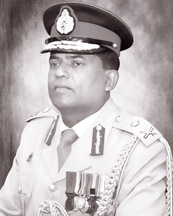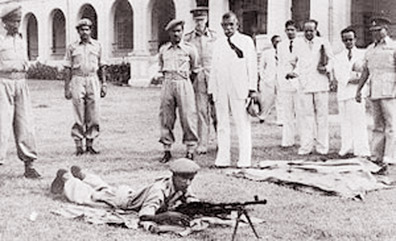A volunteer reserve - the need of the hour
by Dhaneshi Yatawara
The new trends in security need more professionals than soldiers.
Today a battlefield is not the only place where a war can take place.
Cyber war fare is a new trend where only the experts of the field can
mitigate the intensity safe guarding the country. A natural disaster,
epidemic or any such calamity need experts to mitigate the situation.
The trend of the world is to form a volunteer reserve of professionals
who will be called out for duty on requirement. And Sri Lanka, being an
island enjoying the freshness of peace has no exception than a volunteer
reserve to face new trends in threats to national security and disaster
management. Thus in such a back drop Sri Lanka Army's Volunteers are in
a better position to collect this professional reserve.
 |
Commander of
the Volunteer Force,
Major General Prasad Samarasinghe |
|

Kotelawala Defence University Medical Faculty Head,
Colonel Ranjana Seneviratne |
“We need professional people to deal with the new situations that the
world is facing,” said Major General Prasad Samarasinghe, Commander of
the Volunteer Force. With the Volunteer Force anyone can join the Army
at any time with less restrictions and the country would benefit
immensely, according to Maj. Gen. Samarasinghe.
The trend in the world is to develop a stronger Volunteer Force and
specially attracting professionals from various fields. “In any country
professionals are less likely to get attracted to a Regular Force with
its limitations,” he explained. Volunteers have a stronger potential to
serve the country. “In a small and developing country like ours it is
essential for the military and the civil communities to work together
for the development and security of the country. In that way Volunteer
Force can play a bigger role by making a large reserve of professionals
to serve the country,” said Maj. Gen. Samarasinghe.
The origins of the volunteer movement was in 1861 when the governor
wrote to the war office for approval of such a movement. The volunteer
movement grew out of a civilian rifle club and was broad-based for
infantry soldiering by a proclamation issued by the Lieutenant Governor
Sir John Douglas in the government gazette of April 1, 1881 authorizing
the formation of “the Ceylon Light Infantry Volunteers”. Thirteen days
later, Lieutenant Colonel John Scott Armitage was appointed as the
Commanding Officer.
His Royal Highness Albert Edward, Prince of Wales (The Late King
Edward VII) accepted the Honorary Colonelcy of the Regiment and
permitted the use of his motto “Ich Dien” and his personal insignia to
the Regiment.
In 1890, the then Governor of Ceylon, Sir Arthur Hamilton Gordon was
appointed as the Honorary Lieutenant Colonel of the Regiment. In the
earliest years, the Force was armed with the long Snider rifle. This was
replaced in 1890 by the Martini - Henry and there was a further change
in the same year when the entire Force was re-armed with Martini-Enfield
rifles and carbines taking the service 303 cartridge.
|

Sri Lanka's first Prime Minister at a demonstration presented by
the Army Volunteers. (File photo) |
The beginnings of the Ceylon Light Infantry Volunteers formed the
underpinnings not only of the volunteer military movement in Sri Lanka
but also of the Sri Lanka Army.
Today to man the demanding development of the country the Volunteer
Forces are seeking more professionals from all segments of the society.
A senior spokesperson of the Volunteer Force said that their institute
is hoping to open up for enthusiastic citizens from all social segments
and professions who wish to extend their service to the nation holding
the prestige of volunteer forces.
From its beginnings in 1896, as a force of little over thousand
personnel the Sri Lanka Army Volunteer Force has today grown to fifty
five battalions consisting of 1,100 Officers and 45,000 other ranks
deployed in defensive and offensive operations. While a regular soldier
brings to the profession of arms a great degree of expertise, the
volunteer soldier matches it with enthusiasm and a keen sense of duty.
The Sri Lanka Army Volunteer Force (SLAVF) is now enlisting
professionals under the age of 55 and on completion of enlistment they
will be commissioned as Lieutenant Colonels, Colonels and etc
accordingly.
Almost all the urban development projects are presently handled by
army personnel and among them majority consist from the volunteers -
mainly the Engineering Services Regiment, known as ESR. Constructions at
the new port at Hambantota, beautification works around the parliament
area, reconstruction works in Pettah are some of the major works of the
Volunteers. Moreover, the pavement stretching along Bauddhaloka Mawatha
is another picturesque area in the city from the road near Thunmulla
Junction. Driving from Rajagiriya, the pavements with chairs along the
Diyawanna Lake enriches the panoramic view of the city. In the
construction of the new Defence headquarters in Akuregoda the ESR plays
a major role.
According to the Commander of the Volunteer Force there is more work
for the Volunteers. “Volunteers comprised professionals of various
fields and that is our strength in providing a significant service,” the
Commander said.
“I believe it is the time for Sri Lankans to join hands with us to
rebuild the country,Ó” he added.
Today in the Volunteer Force fifteen medical doctors, 88 civil and
mechanical engineers, 20 legal officers, 19 accountants, ten agriculture
officers, ten physiotherapists and 30 English instructors are serving.
In addition seven University academics who joined the Volunteer Force
are now serving in the Kotelawala Defence University. It is General Sir
John Kotelawala who donated land of his Kandawela Estate to set up the
Sir John Kotelawala Defence Academy for the training of young Officer
Cadets, was also a gracious member of the Volunteer Force. Those who
join the Volunteers become members of an esteemed line of citizens
starting from Sri Lanka's First Prime Minister D.S. Senanayake who
served in the Volunteer Artillery as an active member for many years.
Major E.A. Nugawela of the Ceylon Light Infantry Volunteers was the
Minister for Education in the first Cabinet of independent Sri Lanka.
The first Commanding Officer of third Volunteer Battalion the Gemunu
Watch, Colonel C.A. Dharmapala was a Member of Parliament and later
became the Secretary of the Ministry of Defence and Security Advisor to
the President during 1977-1979. Major Montague Jayawickrama, who was the
Minister of Parliamentary Affairs and Plantations and Captain C.P.J.
Senevirathne, who was the Labour Minister during 1977-1983 were active
members of the second Volunteer Ceylon Light Infantry and Ceylon Cadet
Corps respectively. General Ranjan Wijerathne who revived the Planters’
Rifle Corps was the Deputy Minister of Defence during 1989-1992. General
Anuruddha Ratwatte, former deputy Defence Minister was a member of the
second volunteers of the Sinha Regiment.
Today serving as the Medical Faculty head at the Kotelawala Defence
University, Colonel Ranjana Seneviratne said when he joined the
Volunteers in 1990 it was out of sheer inspiration from his family and
Alma Mater. “I joined the volunteer force inspired by my grandfather who
was a history teacher and disciplined education I received from my Alma
Mater Richmond College,” the proud volunteer said. “By the time I
reached my adulthood there was a war going on in the country. And we
hear heavy casualties every day. And I learned that there was a short of
doctors and I believed it was my chance to fulfill the duty. So soon
after I graduated from the Ruhunu University Medical Faculty, as a
pre-intern, I joined the Volunteer Force,” he added. It was the time of
the Operation Balavegaya. It was the largest amphibious assault launched
by the Sri Lankan Military in its history. Operation Balavegaya was
launched in response to siege of Elephant Pass by the LTTE terrorists.
It is believed that Operation Balavegaya was the largest and most
successful military operation of the Sri Lankan Military until Operation
Riviresa in 1995. As a young officer Col. Seneviratne was deployed in
Jaffna.
Creating a turning point with the start of the Eelam War IV,
Volunteers were handed over duties just like the Regular Forces. Yet in
the good old days, when Colonel Seneviratne joined there were the esteem
senior members of the Volunteers. “When I joined there were the officers
from the old Volunteer Force. They were well established with their
civil employments and were coming from respectable social back grounds.
They were holding esteem positions even as civil servants,” explained
Col. Senevirtne.
Some of them had been diplomats, Assistant Government Agents,
Engineers and Principals. “The recruiting officer at the time I joined
was a surveyor by profession. The Second in Command of the Battalion I
joined was Professor Bobby Dias who was a professor in the University of
Colombo. My Commanding officer was Dr. R.C. Rajapakse who was the then
Director of Sri Jaywardanapura Hospital. So there were quite a number of
high profile people from society were serving as volunteers,” he added.
With the changes over time professionals with civil employment found
it difficult to adhere to the full time requirement that came up with
the escalation of terrorist activities. Thus the Volunteer Force became
similar to the Regular Force giving full time commitment to safeguard
the country.
Ensuring the sovereignty and integrity of the country since 1983,
more than 2,500 volunteer personnel were killed in action and over 1,100
were wounded. Col. Seneviratne himself is a proud officer of the
Volunteers decorated with a gallantry award for his bravery during his
unique service as a doctor in Palali camp, Jaffna in 2000.
“Army was a facing a great difficulty during April - July when Palali
camp came under bombardment causing heavy casualty. I worked as a doctor
for the Palali base on a roster basis.
It was my roster during the time the base came under constant
bombardment in 2000 and there were heavy casualties and evacuation was
extremely difficult as air and sea transport were blocked. There was so
much to do to save the soldiers and I did my duty with my utmost
ability," he added in reminiscence of those difficult days.
If the success of an organisation is measured in terms of its
contribution to the society, then the volunteer force of the Sri Lanka
Army reaches veritable heights with leading contributions made by many
of its members in the fight against terrorism and national development.
Today they are the forces are involved in the urban development and
mega construction works that we see around.
A major part of the development work is shouldered by Army's
volunteer forces as it is they who have civil engineers, technicians,
masons, carpenters, plumbers in their organisation that formed the teams
for construction work.
Going beyond these boundaries the Volunteers in their latest campaign
'Api Army' (we are Army) welcomes professionals of all fields to join
their effort to form a volunteer reserve to serve the motherland. As the
first step Doctor Sudath Damsinghe and nurse Pushpa Ramyani joined the
Volunteer Force last week. The Volunteers need such experts from various
fields to strengthen the development of the country.
|

